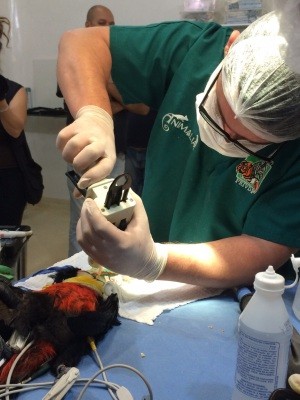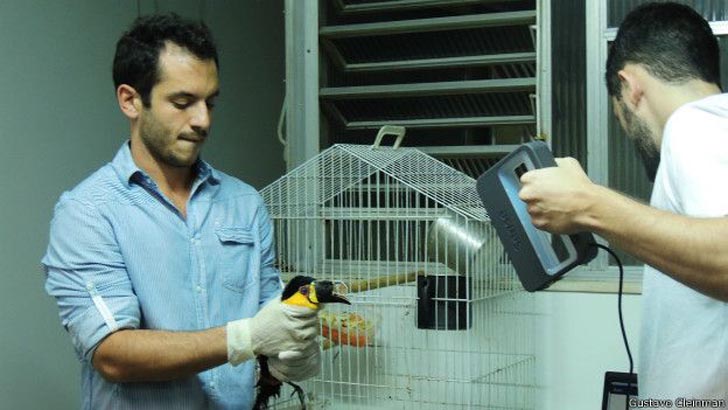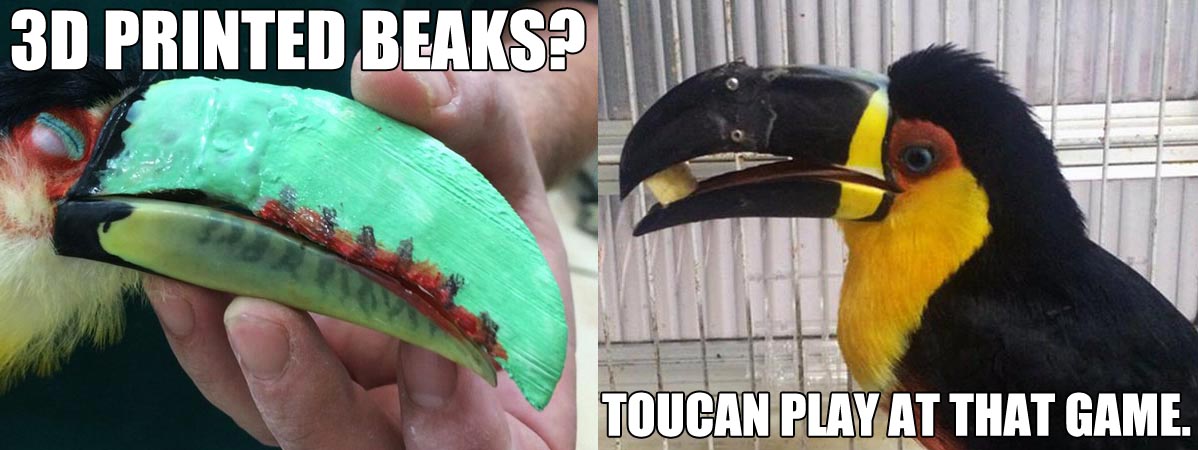They may not be the first toucans to be helped by 3D printing, but would you believe that two toucans in Brazil were aided by 3D printing two days apart? In completely different parts of the country? By two teams completely unaware of one another?
When designer Gustavo Cleinman contacted us on Facebook with a link to a Portuguese TV show featuring a toucan and its 3D printed beak, I started looking for more information on the story. Coming across one link, I began to investigate further. It wasn’t until half way through my write-up that I learned that these were two different toucans.

See, in one case, a green toucan had lost a portion of its beak after flying into a window off the coast of São Paulo. The unnamed bird (which I am naming TuPaul) was then transported to a hospital in Jundiaí, where a group of six different experts worked to replace its beak. Meanwhile, in Rio de Janeiro, a toucan named Tieta had been rescued from an illegal animal market. Gustavo tells me, “When they found her, she was already with the beak broken. We do not know if it was for pure cruelty of the smugglers or because of the conditions of transport, where they put different animals all together in small boxes.”

Without a beak, toucans, and birds in general, have a very difficult time surviving in the wild. Veterinarian Roberto Fecchio, an expert in wildlife dentistry and the doctor responsible for the green toucan’s treatment, explains the dangers of the bird living without its beak (translated from Portuguese), “This toucan could not eat, so if we did not do the operation, he would literally starve to death.” Gustavo adds that the beak also allows the bird to access a gland that produces oil for waterproofing its feathers.

In the case of Tieta, the bird was taken to a government institute, “but they did not have means to provide a 24h care she needed for treatment and feeding her,” Gustavo explains. Fortunately, he continues, “That is when a friend from Instituto Vida Livre, an institute for releasing wild life back into nature, came to know of her situation and contacted me. We pursued our masters together at the Federal University of Rio de Janeiro and decided to organize a team for recovering her beak.”

Typically, in such a situation, doctors attempt to create a prosthesis from the beak of an already deceased toucan. In fact, this is exactly what occurred with TuPaul. First, the team attempted to replace the bird’s beak with that of a deceased toucan, which was sterilized beforehand, but ultimately broke. When that didn’t work, they opted for 3D printing. Gustavo explains that he and his team went through the same thought process, “Normally, the beak is transplanted from a dead toucan, but this method has many problems; as the beaks comes in different shapes and sizes, it’s difficult to find one of the same species and can only be fixed with dentistry resin, which is very fragile for holding the beak. For this reason we decided to 3D print her beak.”
In order to create the prosthetic for TuPaul, designer Cicero Moraes relied on a 3D scan of another toucan beak, before spending two weeks ensuring that it would fit the bird. Moraes says of the end product (translated from Portuguese), “The beak that fits the toucan is cast with two centimeters inside and the underside is closed. It is about 10 centimeters in total and weighs just a few grams, very light.”

The surgery to implant the prosthesis was only an hour long and the bird is already doing much better, the team reports. As the toucan recovers at the Riparian Forest Association Conservation Center in Jundiaí, it has already begun to eat, which was not previously capable of.

Tieta’s story was just as successful. With 15 people involved in the entire process, the team took two months to research and design Tieta’s beak before finally printing the ultimate prosthesis. Using a Sense scanner from 3D Systems, Gustavo scanned the toucan, “but,” he continues, “since we wanted to use the minimum amount of anesthesia possible, the scans did not go well, as she moved a bit. So, I had to use a process combining the scan, which was not very precise for this reason, and reconstruction through photography.”

Unlike the first prosthesis, which was printed in PLA, the team opted for ABS, for its mechanical properties. Moreover, they applied an atoxic enamel, to give the beak Tieta’s natural color, and a specially designed resin to seal the beak. Gustavo says, “We used a resin made from Mamona, a Brazilian tree, know for its resistance and for being totally atoxic, to seal the plastic and prevent the entry of water and bacteria.”

Three weeks after the surgery and Tieta is already recovering. “Previously she was eating only soft fruits,” Gustavo says. “But she can eat normally. Her predatory instincts have returned; she is eating bugs again. And, with the beak again, she is able to access a glandule close to the tail, that produces oil and she uses it for making the feathers waterproof. She had lost this ability, without the beak.”

Gustavo tells me that this all took place without even knowing that a similar story was taking place just 412 km away. “Their surgery happened two days before ours. Incredibly they happened at the same time, but we did not know about each other.”
Projeto Tucano Posted by MateriaBrasil on Tuesday, August 11, 2015
I’m not sure which is more fascinating, that two toucans have been aided so greatly with 3D printing or that two teams of passionate people were able to come to the rescue of their defenseless, feathered friends. Though I hope that no future toucans must suffer the same trauma as this one, I’m happy knowing that there are more and more stories like this, in which dedicated volunteers can find novel solutions for one-of-a-kind creatures.




